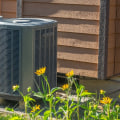If the evaporator coil of your air conditioning unit is leaking and uses R-22, the cost of replacing the coil and recharging the unit with more R-22 can be considerable. In such cases, it is often more economical to replace the entire air conditioning unit with a model that uses a more economical and environmentally friendly refrigerant. However, there are cases where replacing the evaporator coil is the most cost-effective option. If you have a relatively new air conditioning unit and can get a replacement coil that ensures that the two coils work well together, you're likely to find that the cost of replacing the evaporator coil is more affordable than replacing the entire unit.
The evaporator coil is an essential component of any commercial air conditioning system, and its replacement should not be taken lightly. It is important to pay attention to the signs of an evaporator coil malfunction and seek professional assistance when necessary. It's also important to have your coil serviced regularly by a professional HVAC technician, at least once a year, and more often if conditions require it. By taking the necessary steps to properly maintain the commercial evaporator coil, companies can ensure that their HVAC system works at its best. A broken evaporator coil is one of those difficult situations where you really have to consider whether the repair is worth the cost of replacing the part.
Without the evaporator coil, an air conditioning system would not be able to cool a room or maintain a constant temperature. The evaporator coil is the part of an air conditioner or heat pump that absorbs heat and moisture from the air in the house. The reason behind this advice is that air conditioners have an expected lifespan of around 10 to 15 years. It's a good idea to check both coils to reduce the problem and replace the entire unit or replace the leaking coils. Federal regulations control minimum SEER ratings for air conditioners, and modern units must have a rating of 14 or higher in the Northern United States and 15 SEER in the South.
In addition, once a refrigerant leak occurs, it is often more cost-effective to completely replace the coil or the entire unit than to repair the leak and recharge the unit with more refrigerant (especially if the air conditioner contains R-22 refrigerant).The evaporator coil and the condenser coil are two different types of coils used in air conditioning and refrigeration systems. As warm air inside your house blows over this coil, it cools down (and returns to your house), while coolant, now hot, is transported outside to start this process again. When choosing a replacement coil, it is important to select a unit that is the right size for your air conditioning system. That now hot refrigerant is then sent to your outdoor air conditioning unit, where condenser coil is responsible for releasing heat captured outside. Regular maintenance will reduce need for replacing evaporator coil and is vital for overall performance of HVAC system.
Instead, they use refrigerant, or refrigerant, to absorb heat from air, transport that heat outside, and release it into outside air. The cold refrigerant flows through evaporator coil and absorbs heat and moisture from indoor air as it passes through this coil. Since AC evaporator coil malfunction can overload other expensive central air conditioning components and because no one wants to have to deal with faulty or leaking air conditioner, especially in middle of summer, it's important to recognize signs of evaporator coil failure.


